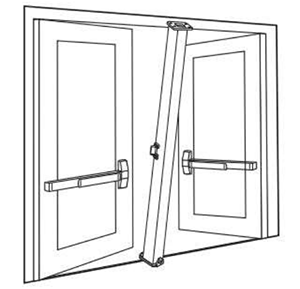Pairs of Doors
When you have a pair of doors, they will (in many cases) lock into each other rather than into the frame like single doors. There will be an active and an inactive door. The active door is the one with the lock on it and is the one used most often in the pair. The inactive door is the one that is usually stationary and only opened when the extra opening width is required. This inactive door will have to lock into the frame and the floor in some way so the when the active doors locks into the inactive door, it's secure with both doors locked.
However, in some cases, both doors can be active. For example; a lot of schools will have exit devices on both doors of a pair and one is used as much as the other. Another example is double egress doors. In this case, both doors open in opposite directions. One is usually used for entering while the other is used for exiting. You'll see these a lot in hospital hallways.
In both examples, there will sometimes be a center "mullion" (either welded onto the frame or the removable type mullion) so that the doors will lock into this just as they would if it were a single door locking into the frame. This would be done with 2 rim exit devices. Another example of both doors of a pair being active is when both have surface vertical rod (SVR) or concealed vertical rod (CVR) exit devices on them. These exit devices lock into the top of the frame and then down into the floor.


When you do have an active and inactive door, the inactive of the pair will have to be secured in some way so that when the active door locks into it, the inactive door cannot be pryed or pushed open allowing unwanted entry. There are several different ways to achieve this, but the two most common are flush bolts or surface bolts. Surface bolts are mounted on the inside surface of the door while flush bolts are mounted in the lock edge of the door and can't be seen when the doors are closed. If you are using exit devices on both doors, then a vertical rod device will keep the inactive door secure so flush bolts or surface bolts would not be used.
A pair of doors will sometimes have an "astragal" which covers the gap between the doors. You can not use this astragal on a pair of doors that have both doors as active as the astragal would require that the door it is mounted on be opened first...thus making the other door inactive until this door is first opened. The top picture above shows a removable mullion, as it is going into the frame. The bottom left picture shows 2 astragals, which screw on to the edge of the door. The first astragal is prepped for a standard 4 7/8" ANSI strike with top and bottom flushbolt preps, and the other is a "blank" astragal. The bottom right picture shows an astragal applied to the inactive door of a pair. This is shown as though you are looking at the top of the doors down to the floor.





